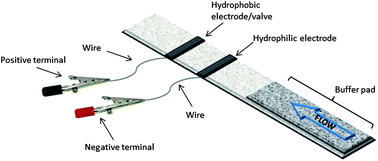An inkjet-printed electrowetting valve for paper-fluidic sensors
Abstract
Paper-fluidic devices have become an emerging trend for micro total analysis systems (microTAS) in the bioengineering field due to their ability to maintain the rapid, sensitive and specific attributes of microfluidic devices. Subsequently, paper-fluidic devices are also more portable, have a lower production cost and are easier to use. However, one of the obstacles in developing paper fluidic devices is the limited ability to control the rate of fluid flow during an assay. In our project, we use electrowetting on dielectrics where a dielectric, which is normally hydrophobic, is polarized and becomes hydrophilic. We have fabricated paper-fluidic devices by inkjet printing and spraying conductive hydrophobic electrodes/valves in conjunction with conductive hydrophilic electrodes which are able to stop the fluid front of phosphate buffered saline (PBS). The hydrophobic valves were then actuated by an applied potential which altered the fluorinated monolayer on the electrode. As the applied potential between the electrodes was increased, the amount of time for the fluid front to pass the valve decreased because the monolayer was altered faster. However, we did not observe significant differences in time as we increased the distance between the electrodes. The valves were also incorporated in a lateral flow assay where the device was used to detect Saccharomyces cerevisiae rRNA sequences. With the ability to control the fluid flow in a paper-fluidic device, more complex and intricate assays can be developed, which not only can be applied in the biomedical, food and environmental fields, but also can be used in low resource settings for the detection of diseases.


 Please wait while we load your content...
Please wait while we load your content...